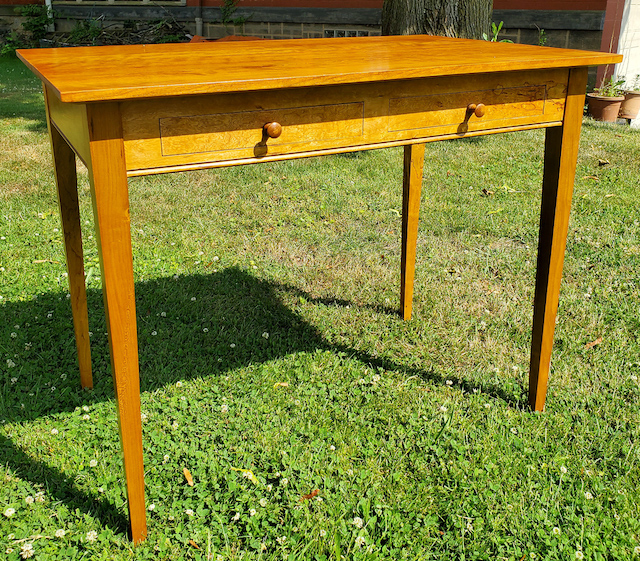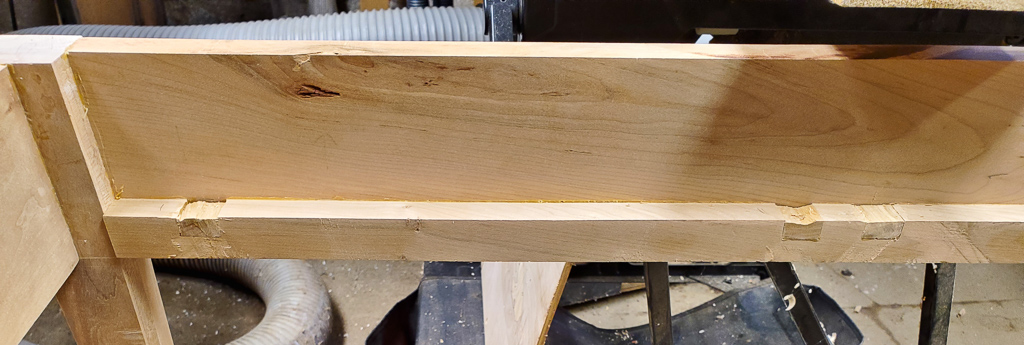06-30-2020, 10:21 AM
Finally finishing the medicine chest build got me back into the shop again, and current circumstances indicated the need for a new piece: A "writing" desk for modern uses. I had a spot in the living room of our 1890's home that was always the odd corner out where we never really had anything, and I had need of a more permanent desk home for myself for work and play with computers (specifically, a laptop, external monitor and keyboard, and all of the ephemera that comes with being a devops engineer). It had to fit into a particular spot, while also being deep enough to efficiently support my devices. It needed a little bit of storage for pens, notebook, external drives and their cables, etc., but not a lot. I wanted it to fit in with our home. I like to work in a simple but older style. I like to learn things when I make something.
The end result:


I work with a combination of hand and machine tools, using machines to help me dimension and cut stock to length, and for some joinery tasks. Panel glue-ups for tops were always a bit of a bane for me, so I decided to get a biscuit joiner to help with that. Looking at those, I also revisited the Domino. Yeah, I'm that guy who ended up getting a Domino, and wow--it really made the joinery for this particular project fly. I often used machines to help me cut the basic mortise and tenon parts and then fit to size with hand tools just to save some time, but I kinda wanted to finish this desk more quickly. That tool was worth every penny I paid for it, especially with some of the upcoming projects I now have on my list. The top panel glue-up came out dead flat without a lot of extra effort or post-clamping clean up, it was a cinch to get the reveal set on the legs and aprons, and I had cut all of the joinery for the base in short order, even including the time I spent playing on some scrap to make sure my layout was doing what I thought it was doing.
I have built a few other small desks and tables, and I've used a simple system of front and back braces, notched to accept L-shaped runners/supports for the drawers, and glued to the aprons. For small drawers, this has worked fine. I was rusty, though, and made a critical mistake this time: I flipped the rear cleat end-for-end at some point, which resulted in the runners being out of square.


The drawers bound, of course. I used a chisel to cut the runners back where they were binding, but it just wasn't right. It felt like a hack job and it was going to bother me every time I used those drawers. So I cut out the runners and resorted to pocket screws to install flat stock between the cleats to act as supports, and then glued side supports on to act as guides for the drawers. This worked great, and I'm much happier about the drawers now.


There's a full write-up with a lot more photos and build process here, if anyone is interested.
The end result:

I work with a combination of hand and machine tools, using machines to help me dimension and cut stock to length, and for some joinery tasks. Panel glue-ups for tops were always a bit of a bane for me, so I decided to get a biscuit joiner to help with that. Looking at those, I also revisited the Domino. Yeah, I'm that guy who ended up getting a Domino, and wow--it really made the joinery for this particular project fly. I often used machines to help me cut the basic mortise and tenon parts and then fit to size with hand tools just to save some time, but I kinda wanted to finish this desk more quickly. That tool was worth every penny I paid for it, especially with some of the upcoming projects I now have on my list. The top panel glue-up came out dead flat without a lot of extra effort or post-clamping clean up, it was a cinch to get the reveal set on the legs and aprons, and I had cut all of the joinery for the base in short order, even including the time I spent playing on some scrap to make sure my layout was doing what I thought it was doing.
I have built a few other small desks and tables, and I've used a simple system of front and back braces, notched to accept L-shaped runners/supports for the drawers, and glued to the aprons. For small drawers, this has worked fine. I was rusty, though, and made a critical mistake this time: I flipped the rear cleat end-for-end at some point, which resulted in the runners being out of square.

The drawers bound, of course. I used a chisel to cut the runners back where they were binding, but it just wasn't right. It felt like a hack job and it was going to bother me every time I used those drawers. So I cut out the runners and resorted to pocket screws to install flat stock between the cleats to act as supports, and then glued side supports on to act as guides for the drawers. This worked great, and I'm much happier about the drawers now.

There's a full write-up with a lot more photos and build process here, if anyone is interested.




